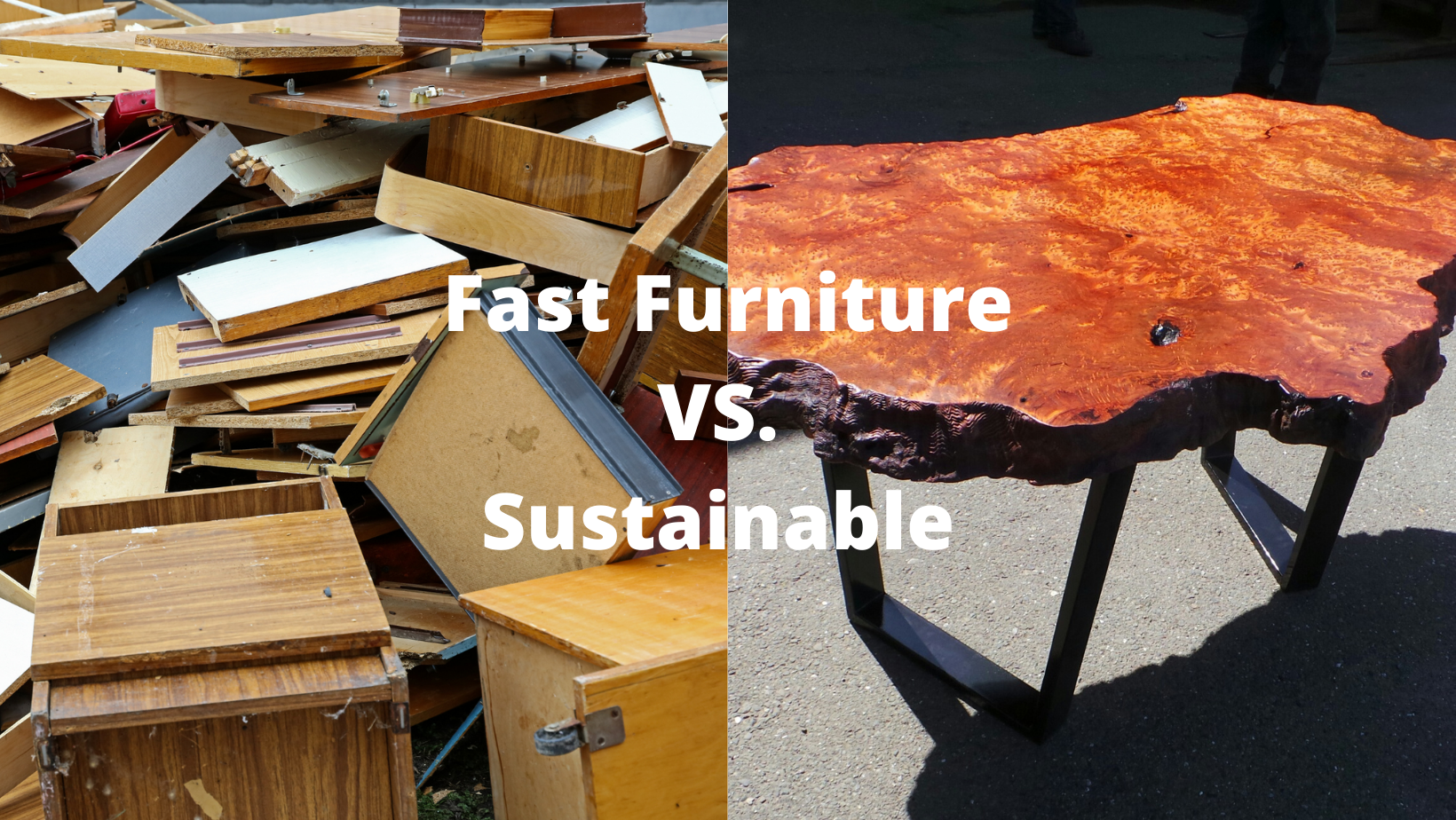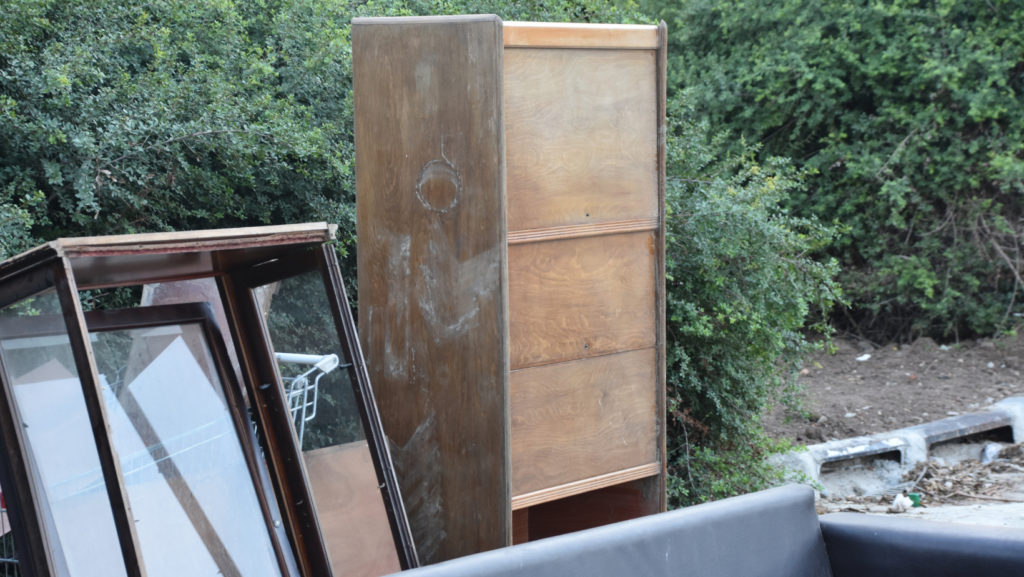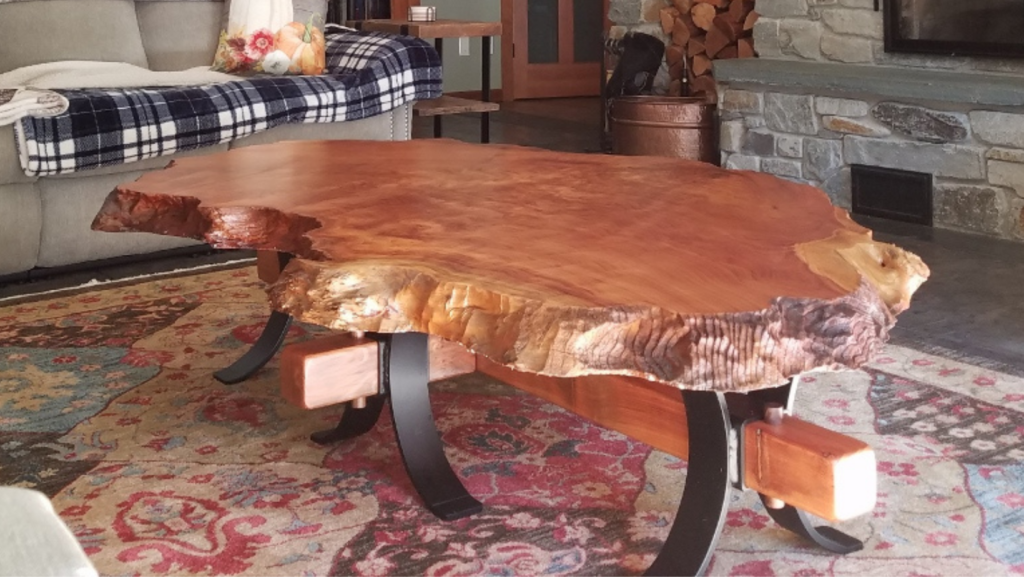
It’s no secret that the current pattern of furniture consumption (cheaper, faster, and more) is simply unsustainable. Consumers once bought furniture intending it to last a lifetime, however, furniture is becoming disposable. Today, most pieces are not made well enough to be collectibles or passed down to younger generations.
These hearty creations were usually produced domestically, reflecting the quality of techniques and solid wood materials used to make the pieces. Since the quality of these items was high, they could undergo the restoration process and be handed down through generations as heirlooms. Unfortunately, the new norm is to purchase temporary pieces of furniture based on the current trends, which are more likely to end up in landfills, rather than collected as timeless décor.
What Is Fast Furniture?
Fast furniture encompasses pieces that are fabricated quickly and designed to last for a brief period (just a few years, tops). Comprised of cheap materials, they are poorly crafted with the intent to break as quickly as the next trend comes along, enticing consumers to buy the next style en vogue currently. Just two to three decades ago, pieces were created to endure and could often be passed down. Manufacturers once used long-lasting woods that could be restored and maintained like maple, redwood burl, cherry, and juniper. Those hearty materials have been mostly replaced by particleboards and plastics. Lifestyle changes of nomadic generations have collided with the manufacturing and production of furniture. Renters, those who lack savings, millennials, or those who move frequently are going to predictably choose inexpensive alternatives.
Thirty years ago, states like North Carolina and Michigan were domestic furniture production powerhouses. During that time, furniture was expensive, but the expense had a direct correlation to the techniques and quality of materials used to create it; the price was transparent. The globalization movement has changed all of that. The amount of energy and water necessary to operate furniture factories and export products all over the world result in the carbon footprint of a cheap coffee table skyrocketing. While custom woodworkers in the states can’t compete with import prices, they tend to exceed expectations when it comes down to quality, craftsmanship, and possible impacts on your health.

Safety & Health Risks
Particleboard is the material most used in fast furniture production and is often referred to as a “green material” because it’s generally made from wood that is left over from other production processes. Wood scraps are dried, bonded with a chemical adhesive, then heated and re-pressed to create usable panels. Designed to disintegrate over time, particle wood uses formaldehyde and other harsh chemicals during the production process. The particleboard is then covered with a plastic veneer, typically by adhering the particle wood with toxic glue.
To make matters worse, since fast furniture is constructed with cheap adhesives and finishing options, these pieces can cause the emittance of hazardous fumes and pollutants. The chemicals used during production like formaldehyde, various heavy metals, and other carcinogens and neurotoxins, can cause “Sick Building Syndrome.” This is considered indoor air pollution, which is an issue the EPA regards as worse than air pollution outdoors. Sadly, fast furniture also exploits natural resources like forestry products, metals, and precious minerals while creating an abundance of waste.
Environmental & Societal Impacts
While consumers save monetarily, it comes with a significant cost and impact on the environment. In 1960, North Americans only threw out around 2 million tons of furniture. However, by 2018, the EPA discovered that furniture accounted for over 12 million tons of urban waste in the United States. Furniture waste, or F-waste as it is dubbed, is the second-largest portion of municipal refuse, representing almost 5 percent of overall garbage.
Around 80 percent of furniture waste goes directly to the dump, which makes it the least recycled items from households. The lion’s share of furniture that currently clutters landfills was manufactured within the last 15 years. Some furniture doesn’t even make it to junkyards, ending up as litter in alleyways and on sidewalks. Outside of the appalling disposal rate of mass-produced furniture, there are even more insidious side effects.
Fast furniture is a huge contributor to deforestation overseas. Sourcing these materials for mass-produced furniture has proven to negatively impact the health of forests in various areas worldwide. The mass-scale deforestation is mainly happening in tropical regions of the world, so generally choosing furniture made from woods grown in the United States is a better choice. However, that can be a challenge since an exceeding number of manufacturers have left the states, and usually downgraded their materials after relocation. Most of the furniture that consumers see for sale in the states is produced abroad to cut costs, leading to murky ethical issues.
The environmental problems that fast furniture creation causes are also closely related to ethical issues. When domestic manufacturing transfers overseas, companies can get away with paying production employees lower wages and unethical treatment. When furniture items are manufactured in foreign countries, those companies have different laws and employee ethics that permit lower pay for high-risk jobs. Ethically made and sourced products are important because they ensure your purchase makes minimal environmental and social impacts. At the end of the day, your consumption impacts the environment and society on a global scale.
Sustainability
Various industries have begun to recognize the sustainability problem. The evaluation of cheap wood furniture has yet to dawn a new day. While a marginal amount of furniture brands are beginning to focus on the sustainability of their products, a vast majority are not, creating a manufacturing trend similar to what’s taking place with fast fashion in the apparel industry.
Most products marked as sustainable or eco-friendly are far from anything environmentally friendly. Companies need to be radically transparent and consider the life cycle of materials and the durability of their furniture, and the larger a piece of furniture is, the more longevity it should have.
A solid wood piece can be sanded and refinished with ease. Something that utilizes particleboard with a laminate finish is difficult to repair the surface damage, even impossible. When exposed to moisture, this material will swell and rot, which makes it a difficult material to refinish or fix for reuse. Once the wood underneath or veneer itself gets damaged, there’s typically no way to repair it. Anything made with veneer and particleboard is simply not sustainable.
The plastic veneer that has wood attached to it can never be recycled. This mix of chemicals and materials that comprise these furniture items makes it practically impossible to process in recycling facilities. Even particleboard itself is also not biodegradable due to the chemicals used during its manufacturing. Outside of the recyclability factor, particleboard also requires more energy to manufacture.
Gen Z and Millennial generations have become more focused on making responsible consumer choices. A straightforward way to address these growing problems is to buy less and buy for durability and quality. However, even if you do invest in a piece that should have endurance, regular maintenance is crucial to ensure that the piece can persevere. Prolonged care for your timber items should include oiling or refinishing, when necessary, as well as tightening up any hardware. At the end of the day, brands that invest in sustainability help create a healthier planet and will personally benefit from a better consumer reputation.

Redwood Burl Inc’s Commitment to Sustainability
Style can be sustainable. While most décor and furniture companies focus on this season’s trend, Redwood Burl, Inc. has spent years perfecting products that we’ll stand behind for years to come, a critical factor in creating a timeless piece. In addition to the quality woods we use, from redwood burl to maple, we’re deliberate about how our products are produced and sourced. We believe one of our largest differentiators is designing our products to be kept for years to come, and being able to upcycle furniture or reuse pieces to give them new life down the road. Truly sustainable furniture is what we source for our clients by creating pieces that can grow with them and their lifestyles.
If you would like to design a sustainable piece your family will cherish for a long time or create your own lasting piece by using something raw from or collection, we’re here to help. Feel free to contact us by phone or email info@redwoodburl.com.
Tags: burl wood, burl wood grain, Custom Burl Wood Furniture, Fireplace Mantels, reclaimed redwood, sustainable materials